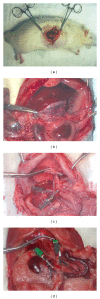The current state of knowledge of hepatic ischemia-reperfusion injury based on its study in experimental models
- PMID: 22649277
- PMCID: PMC3357607
- DOI: 10.1155/2012/298657
The current state of knowledge of hepatic ischemia-reperfusion injury based on its study in experimental models
Abstract
The present review focuses on the numerous experimental models used to study the complexity of hepatic ischemia/reperfusion (I/R) injury. Although experimental models of hepatic I/R injury represent a compromise between the clinical reality and experimental simplification, the clinical transfer of experimental results is problematic because of anatomical and physiological differences and the inevitable simplification of experimental work. In this review, the strengths and limitations of the various models of hepatic I/R are discussed. Several strategies to protect the liver from I/R injury have been developed in animal models and, some of these, might find their way into clinical practice. We also attempt to highlight the fact that the mechanisms responsible for hepatic I/R injury depend on the experimental model used, and therefore the therapeutic strategies also differ according to the model used. Thus, the choice of model must therefore be adapted to the clinical question being answered.
Figures





References
-
- Jaeschke H. Mechanisms of reperfusion injury after warm ischemia of the liver. Journal of Hepatobiliary & Pancreatic Surgery. 1998;5(4):402–408. - PubMed
-
- Teoh NC, Farrell GC. Hepatic ischemia reperfusion injury: pathogenic mechanisms and basis for hepatoprotection. Journal of Gastroenterology and Hepatology. 2003;18(8):891–902. - PubMed
-
- Jaeschke H. Molecular mechanisms of hepatic ischemia-reperfusion injury and preconditioning. American Journal of Physiology, Gastrointestinal and Liver Physiology. 2003;284(1):G15–G26. - PubMed
-
- Clavien PA, Harvey PRC, Strasberg SM. Preservation and reperfusion injuries in liver allografts: an overview and synthesis of current studies. Transplantation. 1992;53(5):957–978. - PubMed
Publication types
MeSH terms
LinkOut - more resources
Full Text Sources
Medical

